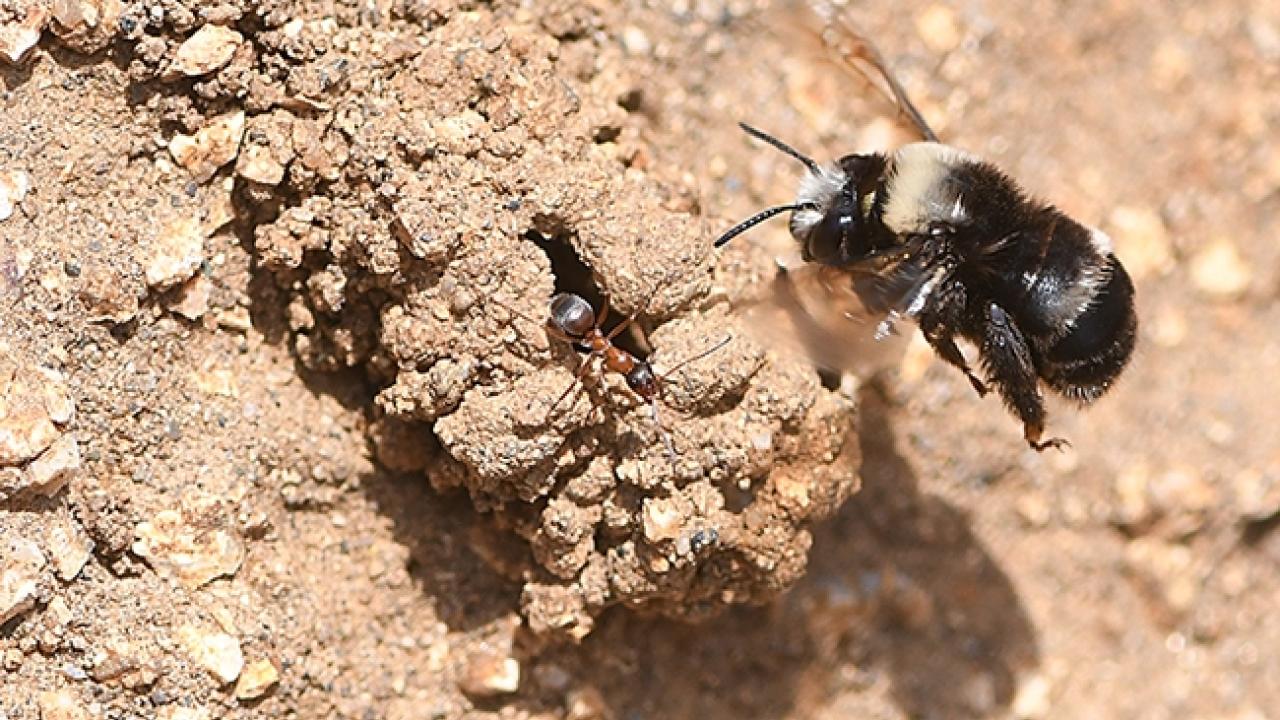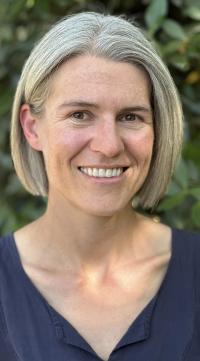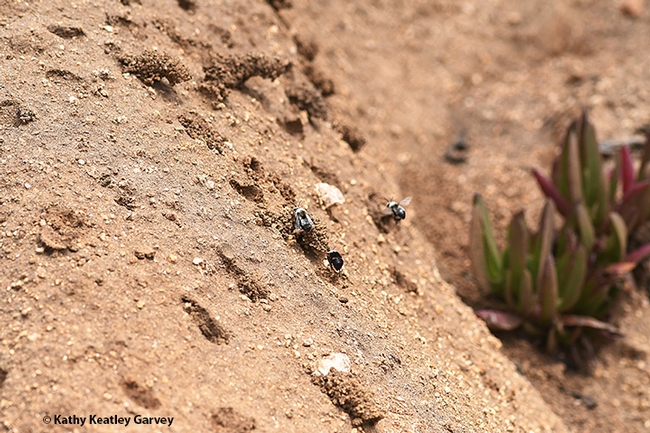
An Exciting Discovery About a Solitary, Ground-Nesting Digger Bee
Microbiologist Shawn Christensen of Vannette Lab Leads Research Team

Microbes found in the immature stages of a solitary bee that nests in sand cliffs along Pacific Coast beaches may be helping the bee defend itself from pathogens and protect it from cold stress, according to newly published research led by microbiologist Shawn Christensen of the Rachel Vannette Lab, UC Davis Department of Entomology and Nematology.
The solitary, ground-nesting digger bee, Anthophora bomboides standfordina, is sometimes called the “Stanford bumble bee digger” because its subspecies name, “stanfordiana,” refers to a 1904 Stanford University collection. It mimics the yellow-faced bumble bee, Bombus vosnesenskii, native to the west coast of North America.
The research publication, “Symbiotic Bacteria and Fungi Proliferate in Diapause and May Enhance Overwintering Survival in a Solitary Bee,” appears in the current issue of the journal, International Society for Microbial Ecology (ISME), and is posted on the National Library of Science website.

“Contrary to what has previously been assumed and found in other systems, we found that dormant--also called diapausing--bees have more abundant symbiotic bacteria and fungi,” said Christensen, who studies microbial interactions/symbioses with plant-pollinator systems and their evolutionary traits in the Vannette lab. Scheduled to receive his doctorate in microbiology from UC Davis this summer, he is the 2024 recipient of the Merton Love Ecology and Dissertation Award, an annual award that celebrates the university’s most outstanding doctoral dissertation in the fields of ecology and evolutionary biology.
“We suspect that this may indicate a stage-specific symbiotic relationship, where the microbes could be helping the dormant bee defend itself from pathogens and protect from cold stress during this particularly vulnerable stage,” Christensen said. “Working with an undergraduate researcher in the lab, Sriram Srinivas, we found that a symbiotic bacteria—Streptomyces--from the developing bees was able to inhibit the growth of bee pathogens.”
The six-member research team, including colleagues from Cornell University, UC Riverside and the University of Arizona, also found “that the microbiome of this solitary bee is very consistent--the same taxa appear in most brood cells, in similar proportions,” said Christensen. “This is uncommon in solitary species, which normally have variable microbiomes due to lack of social transmission. We are still exploring this unique aspect!”
The abstract:
"Host-microbe interactions underlie the development and fitness of many macroorganisms, including bees. Whereas many social bees benefit from vertically transmitted gut bacteria, current data suggests that solitary bees, which comprise the vast majority of species diversity within bees, lack a highly specialized gut microbiome. Here we examine the composition and abundance of bacteria and fungi throughout the complete life cycle of the ground-nesting solitary bee Anthophora bomboides standfordiana. In contrast to expectations, immature bee stages maintain a distinct core microbiome consisting of Actinobacterial genera (Streptomyces, Nocardiodes) and the fungus Moniliella spathulata. Dormant (diapausing) larval bees hosted the most abundant and distinctive bacteria and fungi, attaining 33 and 52 times their initial copy number, respectively. We tested two adaptive hypotheses regarding microbial functions for diapausing bees. First, using isolated bacteria and fungi, we found that Streptomyces from brood cells inhibited the growth of multiple pathogenic filamentous fungi, suggesting a role in pathogen protection during overwintering, when bees face high pathogen pressure. Second, sugar alcohol composition changed in tandem with major changes in fungal abundance, suggesting links with bee cold tolerance or overwintering biology. We find that A. bomboides hosts a conserved core microbiome that may provide key fitness advantages through larval development and diapause, which raises the question of how this microbiome is maintained and faithfully transmitted between generations. Our results suggest that focus on microbiomes of mature or active insect developmental stages may overlook stage-specific symbionts and microbial fitness contributions during host dormancy.”

The bee is commonly found at such sites as the seaside cliffs of the Marin Headlands, a hilly peninsula in southern Marin County; the sandy cliffs of Bodega Head, Sonoma County; and at Moss Beach cliffs, San Mateo County. The females form turreted nests.
Vannette, a community ecologist, Chancellor’s Fellow, and an associate professor and vice chair of the Department of Entomology and Nematology, is a principal investigator of a National Science Foundation grant that funded the project.
“Previous work on bee-microbe interactions has shown how gut bacteria benefit honey bees and other corbiculate social bees but these microbes are limited to social bees,” Vannette said. “We wondered if solitary bees also associate with beneficial microbes and uncovered this previously undescribed partnership between bees, fungi and bacteria. This study opens up new questions in bee ecology and host-microbe interactions: how do solitary bees maintain specific associations with bacteria and fungi? What chemistry are Streptomyces using to suppress fungi? Does this association benefit bees? We think it is likely but ongoing work will examine these questions.”

“We are also thrilled to find this unique symbiosis in a bee species that has been well-studied by previous faculty at UC Davis, including Robbin Thorp,” Vannette said. “UC Davis nematologist Harry Kaya, with graduate student Robin Giblin, also described Bursaphelenchus seani, a nematode that inhabits Anthophora bomboides. Our lab is also investigating links between the brood cell microbiome and the nematodes in this bee species.”
“The species name (bomboides) indicates that it is a bumble bee mimic," according to Thorp (1933-2019), a global authority on bumble bees and a UC Davis distinguished emeritus professor of entomology. ”These bees need a source of fresh water nearby, according to “Females suck up water, regurgitate it on the sandstone bank surface, then dig away at the soft mud. They use some of the mud to build entrance turrets, presumably to help them locate their nests within the aggregation of nests."
Other co-authors of the paper are
- Quinn McFrederick, assistant professor at UC Riverside who studies symbionts (pathogens, commensals, and mutualists) of wild and solitary bees
- Bryan Danforth, professor at Cornell University, who specializes in bee systematics and evolution
- Stephen Buchmann, pollination ecologist affiliated with the Departments of Entomology and of Ecology and Evolutionary Biology at the University of Arizona
- Sriram Srinivas, then a UC Davis undergraduate researcher in the Vannette lab
The researchers wrote that “a solitary bee spends up to 80% of its life developing inside a sealed brood cell; during this time, the developing bee undergoes significant changes in metabolism and morphology—most profoundly during diapause and metamorphosis, respectively. Brood cells are created and provisioned with pollen and nectar by the adult female… they are thought to acquire and filter microbes from the environment anew each generation, excepting occasional endosymbiotic bacteria resulting in variable microbial communities among individuals and populations.”

In their research, they characterized “the composition, abundance, and potential functions of the bacterial and fungal microbiome of the solitary bee Anthophora bomboides stanfordiana Kirby, 1837 (Hymenoptera: Apidae) over eight developmental stages, from two geographic sites, over 2 years using amplicon sequencing, qPCR, microbial isolations, and in vitro trials and assays. We describe a uniquely consistent core microbiome throughout brood development of this solitary bee species.”
Vannette, an international leader in microbial ecology, researches interactions between plants, insects and microbes. “I study the basic and applied aspects of microbial contributions to the interaction between plants and insects,” she said. “I also use these systems to answer basic ecological questions, such as what mechanisms influence plant biodiversity and trait evolution. Much of the work in my lab focuses on how microorganisms affect plant defense against herbivores and plant attraction to pollinators.”
Resources:
- Full Text of research paper, International Society for Microbial Ecology, June 2024
- Rachel Vannette Lab research and members
- Shawn Christensen, Recipient of Merton Love Ecology and Dissertation Award, May 14, 2024
- Presentation delivered by Robbin Thorp at the “Proceedings of the Symposium on Biodiversity of Northwestern California,” October, 1991, Santa Rosa. He researched this digger bee at the Bodega Marine Reserve.
- This Bee Builds Sandcastles at the Beach, PBS Deep Look video
